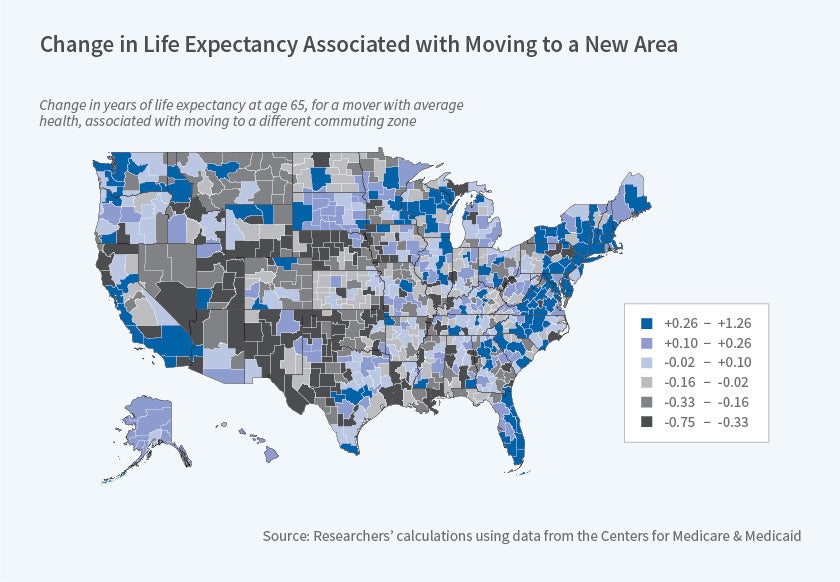Length of Life for Older Americans: Location Matters
Average length of life varies widely across areas of the United States. Two potential drivers of these disparities are differences in environment — such as health care availability and quality, climate, pollution, crime, and accident rates — and differences in the “health capital” of residents — such as genetics and long-term effects of prior health behaviors, medical care, and other past experiences. In Place-Based Drivers of Mortality: Evidence from Migration (NBER Working Paper 25975), researchers Amy Finkelstein, Matthew Gentzkow and Heidi Williams isolate the effect of location on life expectancy at age 65, by examining the mortality outcomes of Medicare beneficiaries who move from one location to another.
The researchers estimate that remaining life expectancy at age 65 increases by 1.1 years, or about 5 percent, for a person moving from an area in the 10th percentile in terms of life expectancy impact to an area in the 90th percentile.
Using a panel of Medicare data, the researchers are able to control for the effect of movers’ origin locations as well as a set of pre-move health measures. They address the fact that healthier individuals tend to choose destinations with lower mortality rates by assuming that the differences in observed health factors that are correlated with movers’ destinations provide a reasonable proxy for unobserved differences as well.
The researchers conclude that “current location has a large causal impact on mortality.” They estimate that remaining life expectancy at age 65 increases by 1.1 years, or about 5 percent, for a person moving from an area in the 10th percentile in terms of life expectancy impact to an area in the 90th percentile. Equalizing the effects of location would eliminate 15 percent of the variation in life expectancy across areas.
Places that have positive life expectancy effects on movers tend to have higher longevity on average, but this correlation is weak. For example, moving to places such as Santa Fe, New Mexico and Denver, Colorado is estimated to reduce life expectancy, even though those locations have relatively high life expectancy on average. As shown in the figure, the areas with the least favorable effects on life expectancy are concentrated in the deep South and Southwest. The areas with the most favorable effects are in the Northeast and parts of Florida and California.
To provide suggestive evidence about the source of these location effects, the researchers describe observable characteristics that are correlated with them. Areas where movers live longer tend to have less extreme climates, less pollution, fewer automobile deaths, and fewer homicides. In addition, their residents tend to have higher income, more education, and better health behaviors, including less smoking and more exercise. These areas also tend to be more urban, and have higher quality hospitals and more primary care physicians and specialists per capita.
The location impacts on mortality emerge immediately after moving and do not change with the amount of time spent in the new location. The timing suggests that location effects are unlikely to be generated by changes in health behaviors that are induced by the new location. Instead, these results suggest that location may affect the life expectancy of the elderly through its effect on health shocks, such as temperature or pollution, as well as the response to those shocks, such as health care. Overall, the findings suggest a role for current location in health outcomes, and highlight the importance of better understanding the mechanisms that could explain this relationship.
— Susan Stewart



